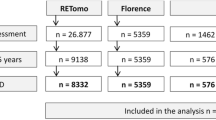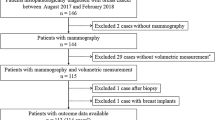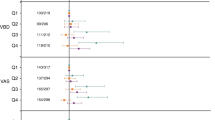Abstract
Purpose
Invasive Lobular Carcinoma (ILC) is frequently a mammographic and diagnostic dilemma; thus any additional information that CAD (Computer-Aided Detection) systems can give radiologists may be helpful. Our study was to evaluate the role of CAD numeric values as indicators of malignancy and the effect of breast density in the diagnosis of ILC.
Materials and methods
Eighty consecutive biopsy-proven ILC cases with CAD (ImageChecker®, Hologic | R2, Santa Clara, CA, versions 2.3, 3.1, 3.2, 5.0, 5.2) diagnosed between June 2002 and December 2004 were retrospectively reviewed. Data included: BIRADS® breast density, whether CAD marked the cancer at diagnosis year or years prior, and lesion type. Study mammograms underwent additional CAD scans (Image Checker® V5.3, V8.0, V8.1) to obtain a numeric value associated with each marker, low values represent increasingly suspicious features.
Results
CAD correctly marked 65% (52/80) of ILC cases, detection was found to decrease with increased breast density. Numeric values of CAD marks at sites of carcinoma showed median score of 171 (range 0 – 1121).
Conclusion
The CAD marker may potentially be used as an additional indicator of suspicious lesion features in all breast densities and higher likelihood that an area on the mammogram requires further investigation.
Similar content being viewed by others
References
Tot T (2003) The diffuse type of invasive lobular carcinoma of the breast: morphology and prognosis. Virchows Arch 443:718–724
Li C, Anderson B, Daling J, Moe R (2003) Trends in incidence rates of invasive lobular and ductal breast carcinoma. JAMA 289(11):1421–1424
Arpino G, Bardou V, Clark G, Elledge R (2004) Infiltrating lobular carcinoma of the breast: tumor characteristics and clinical outcome. Breast Cancer Res 6(3):R149-R156
Page DL, Anderson TJ (1987) Diagnostic histopathology of the breast. Churchill Livingstone, Edinburgh, pp 219–226
Destounis SV, DiNitto P, Young W, Bonaccio E, Zuley M, Willison K (2004) Can computer-aided detection with double reading of screening mammograms help decrease the false-negative rate?. initial experience. Radiology 232:578–584
Roehrig J, Chief Science Officer, R2 Technology, Inc.–A Hologic Company, Santa Clara (Personal Communication)
R2 Corporation, Sunnyvale, CA, presentation “Human Response: Realizing the Potential of CAD”
Destounis SV (2005) Retrospective study evaluating the accuracy of CAD in marking invasive lobular carcinoma. CARS Berlin, Germany
Roehrig J (2005) The Manufacturer’s Perspective. British J Radiol 78:S41–S45
Karssemeijer N, Otten J, Verbeek A, Groenewoud J, de Koning H, Hendricks J, Holland R (2003) Computer-aided detection versus independent double reading of masses on mammograms. Radiology 227:192–200
Skaane P, Kshirsagar A, Young K, Stapleton S (2004) Comparison of CAD performance and independent double-reading in screen-film mammography and full-field digital mammography with soft-copy reading: results from the follow-up of the paired oslo I study, November 29, RSNA, Chicago
Destounis SV, DiNitto P, Young W, Bonaccio E, Zuley M, Willison K (2007) Computer-aided detection in screening mammography: prospective double blinded study in a clinical practice. Radiology (in press)
Mammography Quality Standard Act Regulations, Part 900—Mammography, Subpart B Quality Standards for Certification, www.fda.gov
Elmore J, Barton M, Moceri V, Polk S, Arena P, Fletcher S (1998) Ten year risk of false positive screening mammograms and clinical brest examinations. NEJM 338(16):1089–1096
Cupples T, Cunningham J, Reynolds J (2005) Impact of Computer-aided detection in a regional screening mammography program. AJR 185:944–950
Brem R, Rapelyea J, Zisman G, Hoffmeister J, DeSimio M (2005) Evaluation of breast cancer with a computer-aided detection system by mammographic appearance and histopathology. Cancer 104(5):931–935
Morton M, Whaley D, Brandt K, Amrami K (2006) Screening mammograms: interpretation with computer-aided detection–prospective evaluation. Radiology 239(2):375–383
Dean J, Ilvento C (2006) Improved cancer detection using computer-aided detection with diagnostic and screening mammography: prospective study of 104 cancers. AJR 187:20–28
Roubidoux M, Bailey J, Wray L, Helvie M (2004) Invasive cancers detected after breast cancer screening yielded a negative result: relationship of mammographic density to tumor prognostic factors. Radiology 230:42–48
Aiello E, Buist D, White E, Porter P (2005) Association between mammographic breast density and breast cancer tumor characteristics. Cancer Epidemiol Biomarkers Prev 14(3):662–668
Mandelson M, Oestreicher N, Porter P, White D, Finder C, Taplin S, White E (2000) Breast density as a predictor of mammographic detection: comparison of interval- and screen-detected cancers. JNCI 92(13):1081–1087
Brem RF, Hoffmeister JW, Rapelyea JA, Zisman G, Mohtashemi K, Jindal G, DiSimio M, Rogers S (2005) Impact of breast density on computer-aided detection for breast cancer. AJR AM J Roentgenol 184(6):1968
Ho WT, Lam PW (2003) Clinical performance of computer assisted detection (CAD) system in detecting carcinoma in breasts of different densities. Clin Radiol. 58(2):133–6
Roehrig J Chief Science Officer, R2 Technology, Inc. –A Hologic Company, Santa Clara, Personal Communication
Author information
Authors and Affiliations
Corresponding author
Rights and permissions
About this article
Cite this article
Destounis, S., Hanson, S. & Roehrig, J. Computer-aided-detection marker value and breast density in the detection of invasive lobular carcinoma. Int J CARS 2, 99–104 (2007). https://doi.org/10.1007/s11548-007-0074-8
Received:
Accepted:
Published:
Issue Date:
DOI: https://doi.org/10.1007/s11548-007-0074-8




